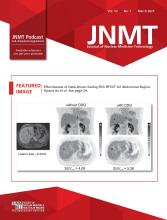Abstract
Diabetic foot infection is the most common etiology of nontraumatic amputation of the lower extremities, and early diagnosis is of great importance in its management. The aim of this prospective study was to evaluate the strength of 99mTc-IgG scintigraphy in diagnosis of osteomyelitis of the diabetic foot and to compare 99mTc-IgG scintigraphy with 99mTc-methylene diphosphonate (MDP) scintigraphy. Methods: A prospective university hospital–based study was performed over 24 mo. Eighteen patients with type II diabetes and foot ulcers (15 men and 3 women; age range, 45–80 y) were referred for imaging because of clinically suspected osteomyelitis. Early (5-h) and late (24-h) 99mTc-IgG scanning and 3-phase skeletal scintigraphy were completed for all patients at a 3- to 4-d interval. Regions of interest over the involved bony sites and the contralateral normal sites were drawn, and the abnormal-to-normal ratios were acquired for both 99mTc-IgG and 99mTc-MDP studies. Results: From a total of 23 lesions, we observed 10 sites of osteomyelitis, 10 sites of cellulitis, and 3 sites of aseptic inflammation confirmed by MRI, clinical presentation, histopathologic examination, and follow-up evaluation as a gold standard. Both 99mTc-IgG and 99mTc-MDP scanning showed excellent sensitivity for diagnosis of osteomyelitis, but the specificity was significantly lower (69.2% and 53.8%, respectively). Sensitivity, specificity, and accuracy in the diagnosis of osteomyelitis were, respectively, 100%, 53.8%, 73.9% for 99mTc-MDP scanning; 100%, 69.2%, 82.6% for 5-h 99mTc-IgG scanning; and 60%, 76.9%, 69.5% for 24-h 99mTc-IgG scanning. There was no significant difference between the semiquantitative indices of 5-h and 24-h 99mTc-IgG scanning for inflammation, cellulitis, and osteomyelitis. Conclusion: Although both 99mTc-IgG and 99mTc-MDP scintigraphy have high sensitivity for the diagnosis of osteomyelitis, the specificity of these studies is poor. For 99mTc-IgG scintigraphy, 5-h images appear to be adequate, and there is little benefit to performing additional imaging at 24 h.







